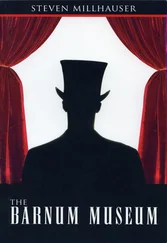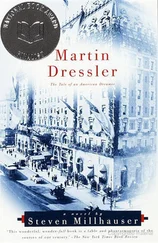Steven Millhauser - Eisenheim the Illusionist
Здесь есть возможность читать онлайн «Steven Millhauser - Eisenheim the Illusionist» весь текст электронной книги совершенно бесплатно (целиком полную версию без сокращений). В некоторых случаях можно слушать аудио, скачать через торрент в формате fb2 и присутствует краткое содержание. Город: New York, Год выпуска: 1994, ISBN: 1994, Издательство: Atlantic Monthly Press, Жанр: Современная проза, на английском языке. Описание произведения, (предисловие) а так же отзывы посетителей доступны на портале библиотеки ЛибКат.
- Название:Eisenheim the Illusionist
- Автор:
- Издательство:Atlantic Monthly Press
- Жанр:
- Год:1994
- Город:New York
- ISBN:978-0871134837
- Рейтинг книги:5 / 5. Голосов: 1
-
Избранное:Добавить в избранное
- Отзывы:
-
Ваша оценка:
- 100
- 1
- 2
- 3
- 4
- 5
Eisenheim the Illusionist: краткое содержание, описание и аннотация
Предлагаем к чтению аннотацию, описание, краткое содержание или предисловие (зависит от того, что написал сам автор книги «Eisenheim the Illusionist»). Если вы не нашли необходимую информацию о книге — напишите в комментариях, мы постараемся отыскать её.
Eisenheim the Illusionist — читать онлайн бесплатно полную книгу (весь текст) целиком
Ниже представлен текст книги, разбитый по страницам. Система сохранения места последней прочитанной страницы, позволяет с удобством читать онлайн бесплатно книгу «Eisenheim the Illusionist», без необходимости каждый раз заново искать на чём Вы остановились. Поставьте закладку, и сможете в любой момент перейти на страницу, на которой закончили чтение.
Интервал:
Закладка:
Early critics were quick to note the young magician's interest in uncanny effects, as in his popular Phantom Portrait. On a darkened stage, a large blank canvas was illuminated by limelight. As Eisenheim made passes with his right hand, the white canvas gradually and mysteriously gave birth to a brighter and brighter painting. Now, it is well known among magicians and mediums that a canvas of unbleached muslin may be painted with chemical solutions that appear invisible when dry; if sulphate of iron is used for blue, nitrate of bismuth for yellow, and copper sulphate for brown, the picture will appear if sprayed with a weak solution of prussiate of potash. An atomizer, concealed in the conjurer's sleeve, gradually brings out the invisible portrait. Eisenheim increased the mysterious effect by producing full-length portraits that began to exhibit lifelike movements of the eyes and lips. The fiendish portrait of an archduke, or a devil, or Eisenheim himself would then read the contents of sealed envelopes, before vanishing at a pass of the magician's wand.
However skillful, a conjurer cannot earn and sustain a major reputation without producing original feats of his own devising. It was clear that the restless young magician would not be content with producing clever variations of familiar tricks, and by 1890 his performances regularly concluded with an illusion of striking originality. A large mirror in a carved frame stood on the stage, facing the audience. A spectator was invited onto the stage, where he was asked to walk around the mirror and examine it to his satisfaction. Eisenheim then asked the spectator to don a hooded red robe and positioned him some ten feet from the mirror, where the vivid red reflection was clearly visible to the audience; the theater was darkened, except for a brightening light that came from within the mirror itself. As the spectator waved his robed arms about, and bowed to his bowing reflection, and leaned from side to side, his reflection began to show signs of disobedience — it crossed its arms over its chest instead of waving them about, it refused to bow. Suddenly the reflection grimaced, removed a knife, and stabbed itself in the chest. The reflection collapsed onto the reflected floor. Now a ghostlike white form rose from the dead reflection and hovered in the mirror; all at once the ghost emerged from the glass, floated toward the startled and sometimes terrified spectator, and at the bidding of Eisenheim rose into the dark and vanished. This masterful illusion mystified even professional magicians, who agreed only that the mirror was a trick cabinet with black-lined doors at the rear and a hidden assistant. The lights were probably concealed in the frame between the glass and the lightly silvered back; as the lights grew brighter the mirror became transparent and a red-robed assistant showed himself in the glass. The ghost was more difficult to explain, despite a long tradition of stage ghosts; it was said that concealed magic lanterns produced the phantom, but no other magician was able to imitate the effect. Even in these early years, before Eisenheim achieved disturbing effects unheard of in the history of stage magic, there was a touch of the uncanny about his illusions; and some said even then that Eisenheim was not a showman at all, but a wizard who had sold his soul to the devil in return for unholy powers.
Eisenheim was a man of medium height, with broad shoulders and large, long-fingered hands. His most striking feature was his powerful head: the black intense eyes in the austerely pale face, the broad black beard, the thrusting forehead with its receding hairline, all lent an appearance of unusual mental force. The newspaper accounts mention a minor trait that must have been highly effective: when he leaned his head forward, in intense concentration, there appeared over his right eyebrow a large vein shaped like an inverted Y.
As the last decade of the old century wore on, Eisenheim gradually came to be acknowledged as the foremost magician of his day. These were the years of the great European tours, which brought him to Egyptian Hall in London and the Théâtre Robert-Houdin in Paris, to royal courts and ducal palaces, to halls in Berlin and Milan, Zurich and Salamanca. Although his repertoire continued to include perfected variations of popular illusions like The Vanishing Lady, The Blue Room, The Flying Watch, The Spirit Cabinet (or Specters of the Inner Sanctum), The Enchanted House, The Magic Kettle, and The Arabian Sack Mystery, he appeared to grow increasingly impatient with known effects and began rapidly replacing them with striking inventions of his own. Among the most notable illusions of those years were The Tower of Babel, in which a small black cone mysteriously grew until it filled the entire stage; The Satanic Crystal Ball, in which a ghostly form summoned from hell smashed through the glass globe and rushed out onto the stage with unearthly cries; and The Book of Demons, in which black smoke rose from an ancient book, which suddenly burst into flames that released hideous dwarfs in hairy jerkins who ran howling across the stage. In 1898 he opened his own theater in Vienna, called simply Eisenheimhaus, or The House of Eisenheim, as if that were his real home and all other dwellings illusory. It was here that he presented The Pied Piper of Hamelin. Holding his wand like a flute, Eisenheim led children from the audience into a misty hill with a cavelike opening and then, with a pass of his wand, caused the entire hill to vanish into thin air. Moments later a black chest materialized, from which the children emerged and looked around in bewilderment before running back to their parents. The children told their parents they had been in a wondrous mountain, with golden tables and chairs and white angels flying in the air; they had no idea how they had gotten into the box, or what had happened to them. A few complaints were made; and when, in another performance, a frightened child told his mother that he had been in hell and seen the devil, who was green and breathed fire, the chief of the Viennese police, one Walther Uhl, paid Eisenheim a visit. The Pied Piper of Hamelin never appeared again, but two results had emerged: a certain disturbing quality in Eisenheim's art was now officially acknowledged, and it was rumored that the stern master was being closely watched by Franz Josef's secret police. This last was unlikely, for the Emperor, unlike his notorious grandfather, took little interest in police espionage; but the rumor surrounded Eisenheim like a mist, blurring his sharp outline, darkening his features, and enhancing his formidable reputation.
Eisenheim was not without rivals, whose challenges he invariably met with a decisiveness, some would say ferocity, that left no doubt of his self-esteem. Two incidents of the last years of the century left a deep impression among contemporaries. In Vienna in 1898 a magician called Benedetti had appeared, Benedetti, whose real name was Paul Henri Cortot, of Lyon, was a master illusionist of extraordinary smoothness and skill; his mistake was to challenge Eisenheim by presenting imitations of original Eisenheim illusions, with clever variations, much as Eisenheim had once alluded to his predecessors in order to outdo them. Eisenheim learned of his rival's presumption and let it be known through the speaking portrait of a devil that ruin awaits the proud. The very next night, on Benedetti's stage, a speaking portrait of Eisenheim intoned in comic accents that ruin awaits the proud. Eisenheim, a proud and brooding man, did not allude to the insult during his Sunday night performance. On Monday night, Benedetti's act went awry: the wand leaped from his fingers and rolled across the stage; two fishbowls with watertight lids came crashing to the floor from beneath Benedetti's cloak; the speaking portrait remained mute; the levitating lady was seen to be resting on black wires. The excitable Benedetti, vowing revenge, accused Eisenheim of criminal tampering; two nights later, before a packed house, Benedetti stepped into a black cabinet, drew a curtain, and was never seen again. The investigation by Herr Uhl failed to produce a trace of foul play. Some said the unfortunate Benedetti had simply chosen the most convenient way of escaping to another city, under a new name, far from the scene of his notorious debacle; others were convinced that Eisenheim had somehow spirited him off, perhaps to hell. Viennese society was enchanted by the scandal, which made the round of the cafes; and Herr Uhl was seen more than once in a stall of the theater, nodding his head appreciatively at some particularly striking effect.
Читать дальшеИнтервал:
Закладка:
Похожие книги на «Eisenheim the Illusionist»
Представляем Вашему вниманию похожие книги на «Eisenheim the Illusionist» списком для выбора. Мы отобрали схожую по названию и смыслу литературу в надежде предоставить читателям больше вариантов отыскать новые, интересные, ещё непрочитанные произведения.
Обсуждение, отзывы о книге «Eisenheim the Illusionist» и просто собственные мнения читателей. Оставьте ваши комментарии, напишите, что Вы думаете о произведении, его смысле или главных героях. Укажите что конкретно понравилось, а что нет, и почему Вы так считаете.












